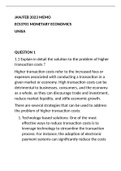JAN/FEB 2023 MEMO
ECS3701 MONETARY ECONOMICS
UNISA
QUESTION 1
1.1 Explain in detail the solution to the problem of higher
transaction costs ?
Higher transaction costs refer to the increased fees or
expenses associated with conducting a transaction in a
given market or economy. High transaction costs can be
detrimental to businesses, consumers, and the economy
as a whole, as they can discourage trade and investment,
reduce market liquidity, and stifle economic growth.
There are several strategies that can be used to address
the problem of higher transaction costs:
1. Technology-based solutions: One of the most
effective ways to reduce transaction costs is to
leverage technology to streamline the transaction
process. For instance, the adoption of electronic
payment systems can significantly reduce the costs
, of handling cash or checks. Similarly, the use of
blockchain technology can help to simplify and
automate complex transaction processes, thereby
reducing the need for intermediaries and minimizing
transaction fees.
2. Regulatory reforms: Governments can enact policies
and regulations that aim to reduce transaction costs.
For example, laws that increase competition among
market participants or that promote transparency
and information sharing can help to lower the costs
of transactions. Similarly, policies that reduce
bureaucratic red tape and streamline regulatory
processes can help to minimize transaction fees and
improve market efficiency.
3. Improved infrastructure: Another approach to
reducing transaction costs is to invest in better
infrastructure. This could include building better
roads, ports, and airports, as well as improving the
telecommunications and internet infrastructure. By
improving the efficiency of transportation and
communication, transaction costs can be reduced,
and trade and investment can be facilitated.
4. Education and training: One of the main drivers of
high transaction costs is the lack of knowledge and
, skills among market participants. Providing
education and training to businesses and consumers
on how to reduce transaction costs and improve
market efficiency can help to create a more
informed and skilled workforce, thereby reducing
transaction costs.
5. Collaboration and cooperation: Finally, reducing
transaction costs often requires collaboration and
cooperation among market participants. For
instance, suppliers and buyers can work together to
streamline the supply chain, reduce shipping costs,
and improve inventory management. Similarly,
businesses and consumers can cooperate to develop
common standards and protocols that help to
reduce transaction fees and improve market
efficiency.
In conclusion, the problem of higher transaction costs
can be addressed through a combination of technology-
based solutions, regulatory reforms, improved
infrastructure, education and training, and collaboration
and cooperation. By reducing transaction costs,
businesses and consumers can enjoy a more efficient and
cost-effective market, which can ultimately drive
economic growth and prosperity.




